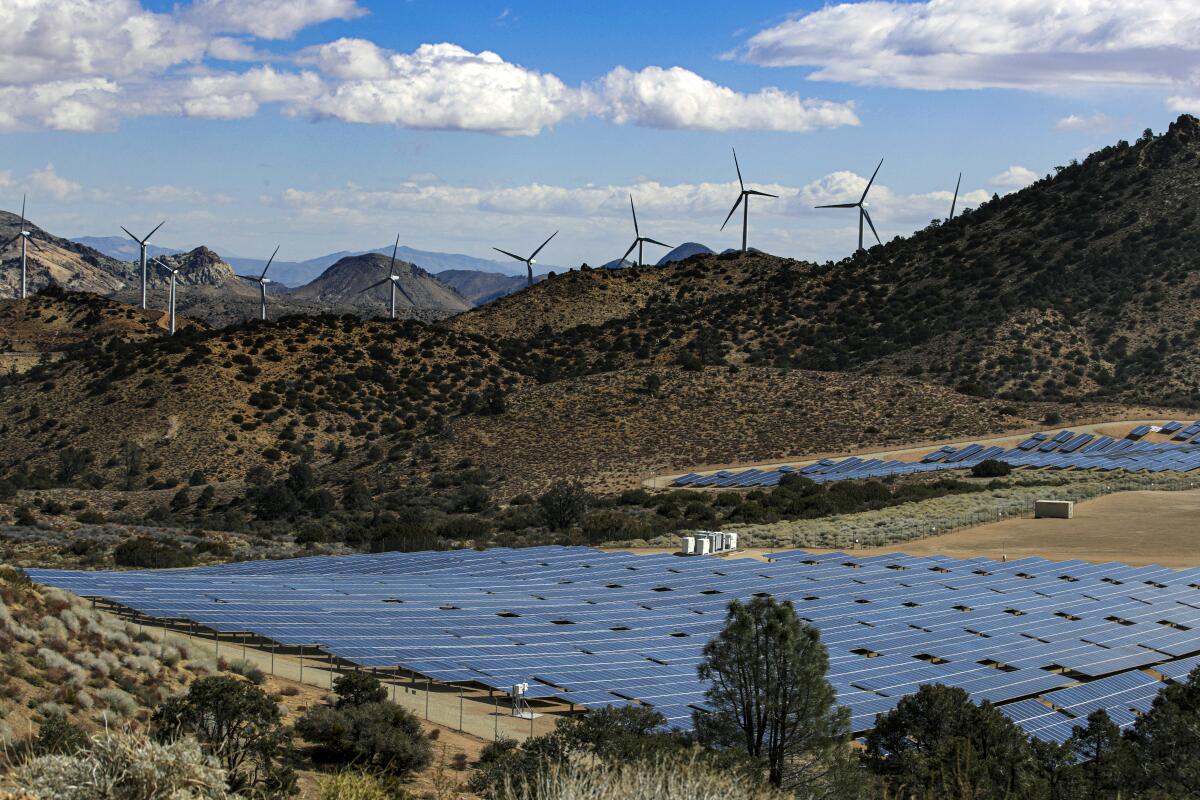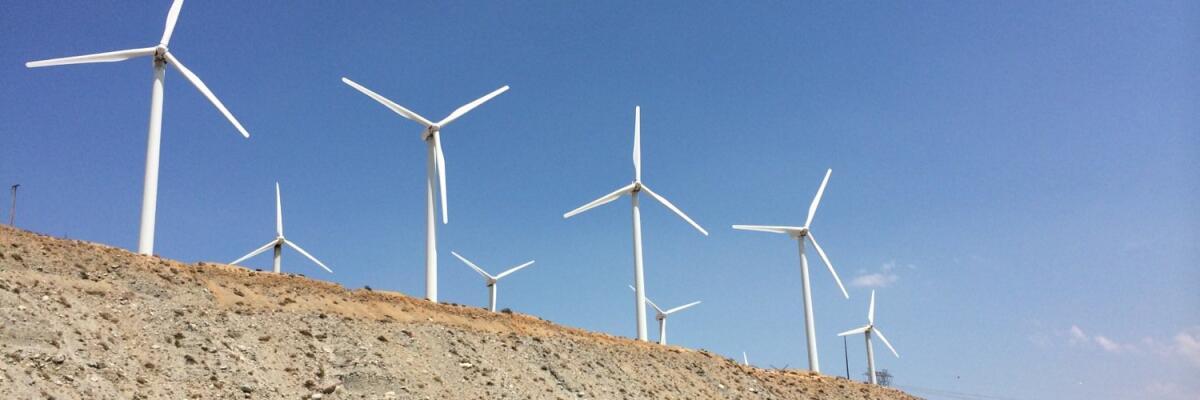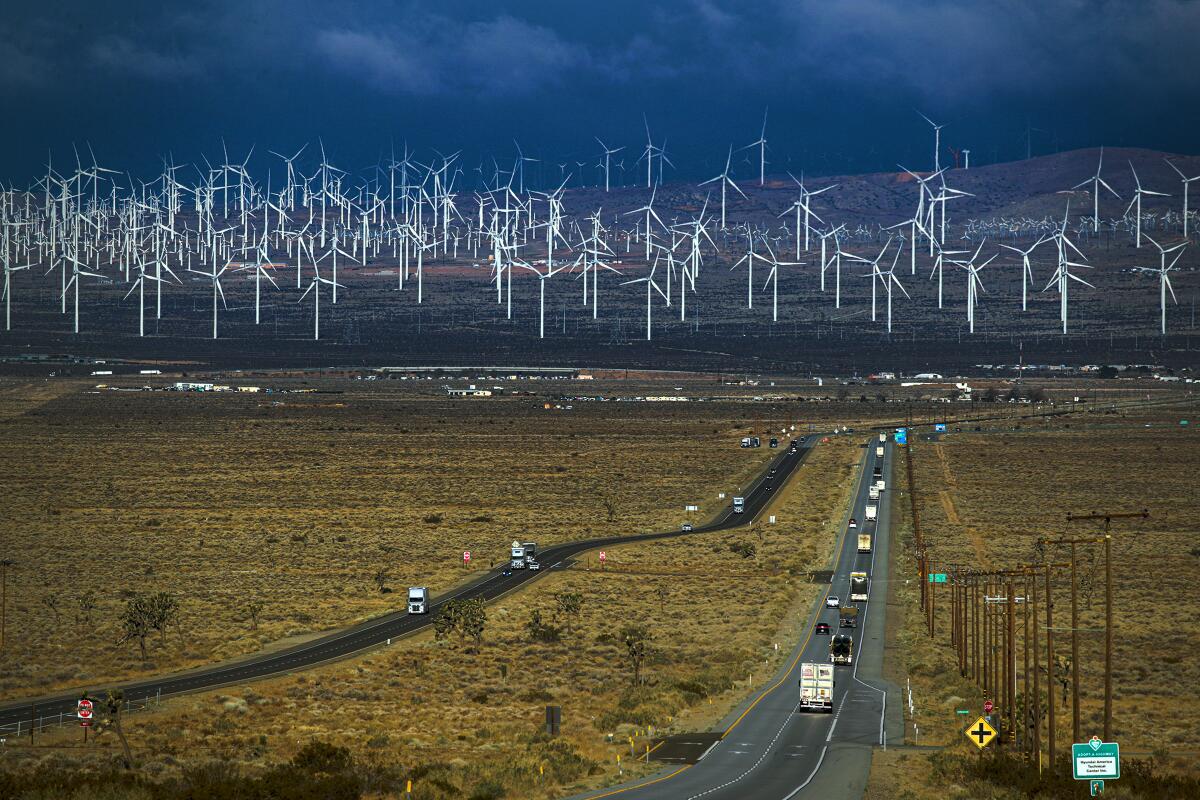Newsletter: Are solar and wind farms ugly or beautiful? There’s a lot riding on the answer

- Share via
This is the May 27, 2021, edition of Boiling Point, a weekly newsletter about climate change and the environment in California and the American West. Sign up here to get it in your inbox.
It was a huge moment in the fight against climate change. The Biden administration announced this week that it would open more than 250,000 acres of ocean water off California’s Central Coast to wind energy development.
The offshore wind industry has struggled to get a toehold on the West Coast, even as projects begin to take off on the Atlantic Seaboard. Ocean breezes could play a big role in transitioning the Western electric grid off fossil fuels, especially because the region’s offshore gusts blow strong after sundown, as Anna M. Phillips, Rosanna Xia and I wrote for The Times.
Still, here was a major hitch on my mind while reporting this story. As much potential as there is in offshore wind, it’s one of the best examples of an inconvenient truth: that renewable energy facilities are often seen as terrible eyesores.
Lots of people believe that fields of wind turbines or solar panels ruin a gorgeous view, and that doesn’t make them climate deniers. It’s a common opinion, I’ve found — not just in wealthy coastal communities like Nantucket island, the Massachusetts enclave where wealthy homeowners helped defeat a proposal for America’s first offshore wind farm, but also in rural areas across the West, where many residents value the uncluttered views and distinctly non-industrialized character of the landscapes.
There are case studies everywhere, from the desert towns of California’s San Bernardino County to the San Diego backcountry, eastern Washington state, the San Francisco Bay Area, Nevada’s Mormon Mesa and Laramie, Wyo. Some of the arguments are more compelling than others. I was a bit confused, for instance, to read about Montanans trying to block a lithium-ion battery installation in Butte, considering it would be built next to an existing electric substation — not exactly a pristine viewshed.
There are lots of obstacles to transitioning to 100% clean energy — the enduring political power of the oil and gas industry, for one. But if you ask me, local opposition to renewable energy projects could be as significant a roadblock as any.
The number of facilities that will be needed is staggering, and the country has only just begun to scratch the surface. Even with a significant push for rooftop solar and other small urban installations — which could lead to large cost savings, some researchers have found — we’re talking about a dramatic transformation of American landscapes, particularly in the sunny, windy West.
Personally, I think solar farms and wind turbines look pretty cool, probably in part because I grew up with an understanding of them as a public good. When I lived in Palm Springs, I learned to take pride in the iconic wind farms of the San Gorgonio Pass — which were once seen as a blight on the beautiful mountain scenery that would hurt tourism but are now mostly beloved.

I also realize not everyone feels that way — even some folks who are super concerned about the climate crisis.
When I asked the people of Twitter for their thoughts on the aesthetics of renewable energy, I got a range of responses. One person pointed me toward UC Berkeley research suggesting proximity to wind turbines can lead to lower property values. Another shared a nighttime video of blinking aircraft safety lights atop a field of wind turbines, calling them “an abomination [that] ruin our night sky.” Someone sent me a version of Van Gogh’s “The Starry Night” featuring a wind turbine in the foreground.
Several folks made comparisons to fossil fuels, with one person posting a definitely-not-pretty photo of an oil refinery and another writing that “poor aesthetics of renewable energy facilities is a misinformation campaign perpetuated by oil and gas advocates.”
I also asked some of my L.A. Times colleagues what they think — particularly those who, like me, love to hike.
Rachel Schnalzer, who writes our (excellent) travel newsletter, Escapes, said that while she doesn’t like reaching a mountain peak and seeing “a sea of distribution centers down below,” solar and wind farms don’t bother her. Utility journalism editor Matthew Ballinger said that while he’s “used to the signs of civilization being present in the San Gabriel and Santa Monica mountains,” it would be a “real bummer” to see vistas in more remote places, such as Joshua Tree National Park, covered by solar panels.
“That said, I’d rather have that than for actual Joshua trees to go extinct or something because we can’t control our carbon output,” he added.

Another interesting comment came from Mary Forgione, who writes our (also excellent) outdoors newsletter, The Wild.
“I must confess, I’m ALL for solar/wind farms — until I get to the desert and see the big aggregate farms and think, ‘Oh, I thought this was going to be rooftop solar, not something as ugly as a sprawling power plant,’” she wrote. “And then I think, ‘Oh, coal is so awful and has killed so many miners and others from pollution. Maybe I better stop thinking about the downsides of these alternatives and be grateful for the tech shift.’”
For some expert commentary, I turned to Josh Hohn. He’s based in San Francisco and runs the visual resources practice at Stantec, a consulting firm that helps conduct legally mandated environmental analyses for solar and wind farms. He has a fascinating job, which he described as helping people understand what renewable energy facilities will actually look like.
“If you don’t do that, it leaves people to imagine by their own devices,” he said. “We try to get to a point of shared visual understanding, so that any public debate about a project’s aesthetic merits is focused on what has been proposed.”
Hohn told me his work involves visiting proposed project sites and creating detailed visual simulations. He writes technical reports that consider factors such as scenic highways and hiking trails, whether the landscape has already been altered by humans, and basic design principles such as form, line, color and texture. Hohn and his colleagues determine whether a project would have “significant and unavoidable” visual impacts, with the final decision on approval or disapproval left to public officials.
“I’m a native Californian, and I think we’ve got maybe a higher tolerance for evolving landscapes out here,” he said. “That’s me saying that as a hiker who has chosen to go somewhere and doesn’t mind turning a corner and seeing turbines. That’s not me as a landowner who has chosen to go live somewhere remote, where I might not want to see that kind of infrastructure.”
“People broadly support this stuff, just not near them,” he added. “It very often comes down to the aesthetics.”
Hohn also referred me to Argonne National Laboratory scientist Robert Sullivan, who retired in January after 14 years studying the aesthetics of renewable energy facilities and power lines for the federally funded, Illinois-based lab. Much of his work involved contracting for government agencies such as the National Park Service and the Bureau of Ocean Energy Management.
Sullivan told me that analyzing visual impacts is less subjective than you might think. It involves figuring out where a piece of energy infrastructure would be visible from — possibly as far away as several dozen miles for an offshore wind farm — and what people would see from different vantage points. He said flat fields of solar panels typically have the lowest impacts, at least compared to wind turbines that can tower hundreds of feet high and electric lines that can cut across landscapes for hundreds of miles.
“It’s not the kind of thing where you’re trying to say, ‘I can tell you for every single person that you give me how they’re going to feel about this,’” he said. “But pretty objectively, you can say [whether] this is going to be pretty prominent in the visual field.”
A field of wind turbines visible from Mt. Rushmore, for instance, would be an objectively big deal. Whereas the same facility on Midwestern farmland, which has already been modified by human activity, would have less of an impact.
To be clear, not all opposition to solar and wind farms is based on aesthetics. There are plenty of wildlife and ecosystem reasons a particular spot might be wrong for a renewable energy facility. Noise concerns are also sometimes raised about wind farms.
But if we’re going to confront climate change, dealing with visual impacts is key. There’s no way around it. Especially in the West, there will be difficult conversations about where to put solar farms, wind turbines and transmission lines.
Sullivan spent much of his career helping government agencies and the public make informed, nuanced decisions about these things. So I was somewhat surprised by his answer when I asked him how we might go about resolving the inevitable tensions.
In order to address climate change, he said, we might just have to build stuff even where the aesthetics are bad.
“There’s no question in my mind that we need to be building renewable energy projects, and it could be that ultimately the decision must be taken by society that we don’t give a crap what the visual impacts are,” he said.
It’s a provocative sentiment, and I’m curious to hear what you all think. Send me an email or tweet at me. One way or another, this is a conversation we’re going to need to have as a society. We might as well start now.
In the meantime, here’s what’s happening around the West:
TOP STORIES
The Metropolitan Water District, Southern California’s largest water supplier and a power player in Western politics, has chosen a new leader. But the decision isn’t final yet, amid a behind-the-scenes struggle for control with major consequences for the nearly 19 million people served by the agency. Read my story for all the details, including the involvement of former Nevada water boss Pat Mulroy and what this means for the Colorado River and more local sources of supply, such as sewage recycling.
If the lights go out in California this summer, will people blame Gov. Gavin Newsom and vote to remove him from office? And does it matter if the outages are to prevent wildfires, or because of power shortages like we experienced last summer? My Sacramento-based colleague Taryn Luna took a nuanced look at those questions. It’s worth noting that residents of other Western states, including Nevada and Oregon, also face the growing likelihood of intentional blackouts to avert wildfire ignitions.
An expansion of L.A.’s 710 freeway would require eviction of low-income Latino residents and possibly violate the Clean Air Act by increasing pollution. But although officials are rethinking the project, they haven’t canceled it, Liam Dillon reports for The Times. One activist called the proposal a “very clear depiction” of environmental racism. It’s also an example of why Los Angeles County is investing billions of dollars in improved public transit. The county broke ground this week on the last leg of the Purple Line subway extension to the Westside, Hayley Smith and Lila Seidman report. Personally, I can’t wait to start riding the thing.
WATER IN THE WEST

“In Los Angeles, a city with little green space and even less water, it couldn’t be more essential to create water-conscious public spaces that are also joyful and aesthetically pleasing.” That’s the conclusion of L.A. Times columnist Carolina A. Miranda in this excellent piece about rainwater capture and filtration at Magic Johnson Park, the site of a former oil storage facility in South L.A. My colleague Louis Sahagún also writes that there’s an agreement to turn an old oil field into a public park in Newport Beach.
South of the border, the governor of Baja California wants to seize a private golf course and make it a public park. The San Diego Union-Tribune’s Wendy Fry writes that Tijuana — Mexico’s most densely populated city — doesn’t have enough parks, leaving its nearly 2 million residents short of green spaces to exercise, breathe fresh air and stay cool as the planet warms.
What should Sacramento be doing right now to help the Golden State cope with water scarcity? Columnist George Skelton looks at several options on the table, including proposals from Gov. Newsom to offer financial relief to low-income families struggling to pay their water bills and provide clean drinking water to communities whose wells have run dry. And in case anyone had forgotten about the water-energy nexus that I keep writing about, Reuters reports that just 7% of California’s electricity has come from hydropower so far this year as drought conditions worsen, down from an average of 16% over the last five years.
THE ENERGY TRANSITION
The battery of Ford’s electric F-150 Lightning can serve as a backup generator to keep a house running when the power goes out. It will also be able to power up tools at work sites and campsites, my colleague Russ Mitchell reports. Electric cars could obviously play a huge role in slashing planet-warming emissions, but one unintended side effect is less gas tax revenues to fund road and bridge repairs. As more drivers go electric — and as gasoline-fueled cars get more efficient — California officials are considering a fee based on vehicle miles traveled, even after a recent gas tax increase, The Times’ Patrick McGreevy reports.
Exxon Mobil shareholders voted this week to add at least two directors backed by an activist hedge fund to the company’s board, in an effort to push the oil giant toward cleaner energy. L.A. Times columnist Michael Hiltzik explained why it matters, writing ahead of the vote that under CEO Darren Woods, Exxon “has done less than many of its peers to pivot away from fossil fuels and toward renewable energy.” Details of the shareholder vote here, from Reuters’ Jennifer Hiller and Svea Herbst-Bayliss.
New Mexico’s budget has never been more dependent on oil and gas, and the industry dominates campaign spending across every level of government. Tremendous reporting by Lindsay Fendt for Searchlight New Mexico, showing how the state continues to find itself under the sway of fossil fuel firms, even as Gov. Michelle Lujan Grisham talks about transitioning to clean energy. That transition could involve a focus on hydrogen production, per the Albuquerque Journal’s Kevin Robinson-Avila.
Toward a more sustainable California
Get Boiling Point, our newsletter exploring climate change, energy and the environment, and become part of the conversation — and the solution.
You may occasionally receive promotional content from the Los Angeles Times.
ON OUR PUBLIC LANDS
President Biden has yet to stop old-growth forests from being logged on federal lands in the Pacific Northwest and Alaska, despite the significant damage to climate and biodiversity. Important piece by the Huffington Post’s Chris D’Angelo, who points out that some logging projects are moving forward even as the Biden administration promises to “invest in forest protection and forest management” as part of its “30 by 30” strategy to conserve 30% of America’s lands and waters by 2030.
Cobalt is a key ingredient in lithium-ion batteries, and much of it is produced by child laborers in the Democratic Republic of the Congo. There’s potential for a big cobalt mine in Utah — but the area might be returned to Grand Staircase-Escalante National Monument by President Biden, which would probably kill the mine, as Amy Joi O’Donoghue reports for the Deseret News. It’s a fascinating example of the environmental tensions created by the need for minerals to fuel the clean energy transition.
We often think of wildlife as being out in the wild — but sometimes they make their presence known in the paved-over landscapes we call cities. My colleague Susanne Rust wrote about a mountain lion prowling San Francisco for two days before retreating up a tree, and the dozen dead whales that have washed ashore in the Bay Area this year. The Times’ Louis Sahagún, meanwhile, tried to figure out where the wolf known as OR-93 has gone after seemingly vanishing in San Luis Obispo County.
ONE MORE THING

The anti-public lands extremist Ammon Bundy, who led an armed takeover of Oregon’s Malheur National Wildlife Refuge, filed paperwork to run for governor of Idaho, the Associated Press reports.
Meanwhile, a judge said Bundy can remain free until trial on charges unrelated to Malheur, ruling that his “repeated arrests for trespassing at the Idaho Capitol last month did not merit his immediate incarceration,” Jennifer Yachnin reports for E&E News.
We’ll be back in your inbox next week. If you enjoyed this newsletter, please consider forwarding it to your friends and colleagues.






